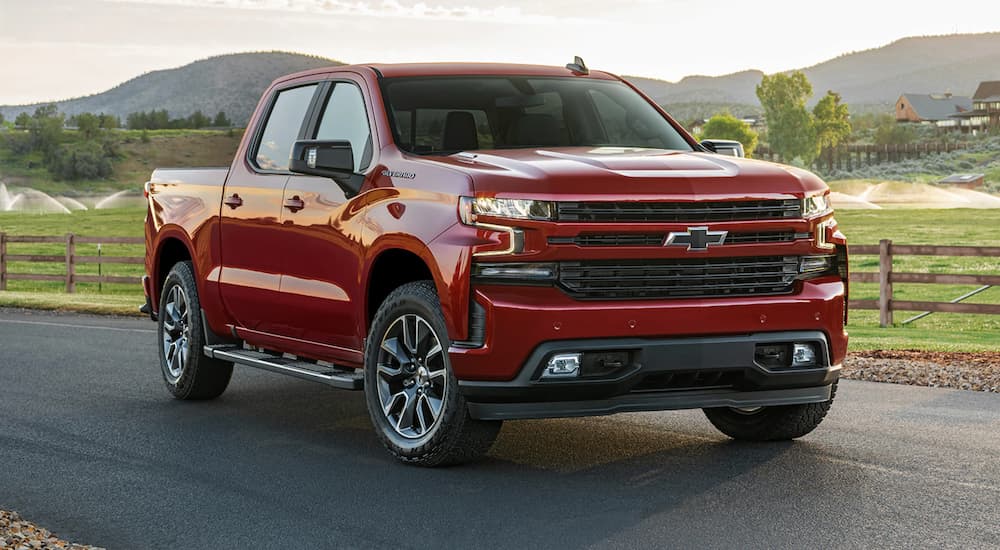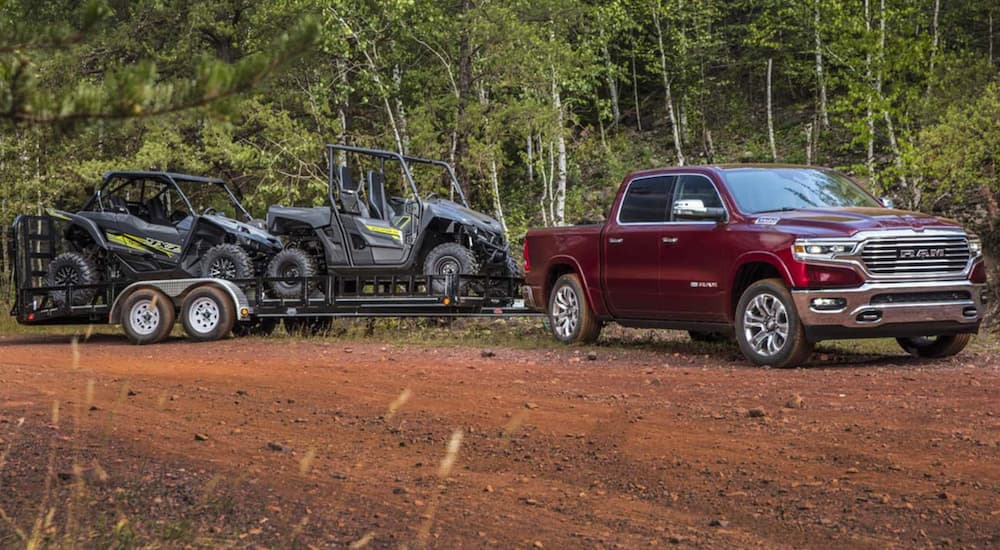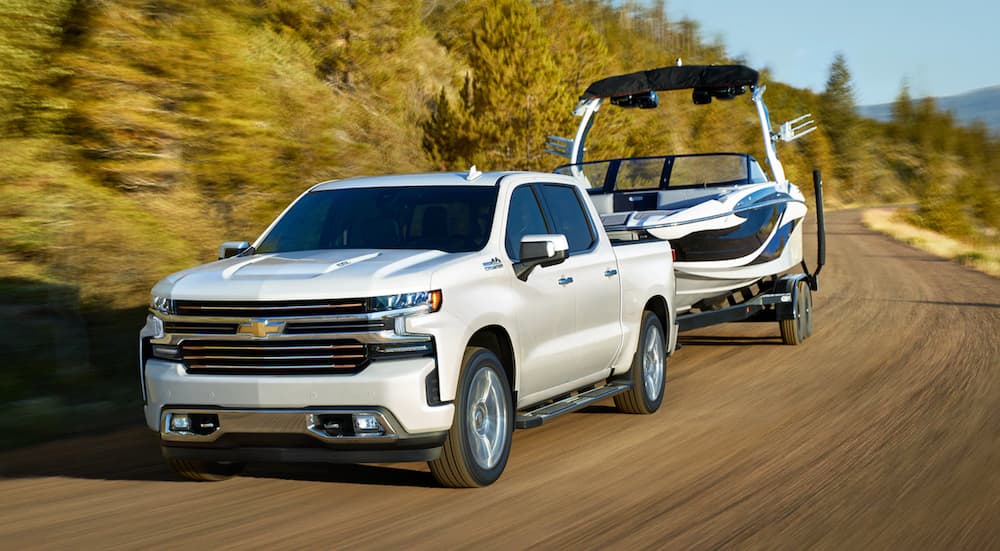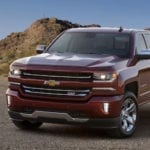Everybody loves a good battle for the best truck, and in today’s market, there are plenty of contenders. Ram has been doing a lot of retooling to try to take first place in the truck market, and its new popularity is a sign that buyers like the new Rams. With innovations to the design in 2019 and an outrageous off-road variant in 2021, Ram is rising in sales. Chevy, however, still enjoys a top slot in sales with the crowd-favorite Silverado. It’s a solid truck, and Chevy hasn’t been slacking on innovations of its own, also introducing a new generation in 2019. One area of the competition is in the diesel engine arena. How does the 2021 Chevy Silverado 1500 diesel vs 2021 Ram 1500 diesel shake out?
The Engines
When it comes to true performance, the engine matters. In one corner, Chevy revs up the 2021 Silverado with a 3.0-liter turbocharged inline-six Duramax diesel engine that churns out 277 hp and 460 lb-ft of torque. It’s paired to a ten-speed automatic transmission and incorporates automatic start and stop technology to save fuel. Current numbers reflect that the Silverado 1500 has the best fuel efficiency of any truck on the market, at 23 MPG in the city and 33 MPG on the highway. With this engine equipped, it has a maximum towing capacity of 9,500 lbs depending on the specific truck configurations. To have the diesel engine, you do need to purchase the LT, RST, LTZ, or High Country trims.
In the other corner, the 2021 Ram 1500 rumbles with a 3.0-liter turbocharged V6 diesel that makes 260 horsepower and 480 lb-ft of torque. This engine lays claim to best-in-class torque, and it has a maximum towing capacity of 12,560 lbs when properly equipped. However, it’s paired with an eight-speed automatic transmission, and fuel economy for Ram’s diesel is a touch lower at 22 MPG in the city and 33 MPG on the highway. This engine is also not available with all cab and bed choices.
Knowing all the numbers doesn’t really tell the whole story of which contender will come out the winner when it comes to performance. First, Chevy has chosen to employ an inline-six option over the V6 engine in the Ram. An inline-six is much less complicated to repair due to the simplicity of its design, and it tends to have a better balance with less engine vibration. V6 engines perform as well as the inline-six, but with more working parts in a more compact space. The V6 will save space under the hood, but it has more complexity to be so compact, which translates to a more difficult engine to repair.
While Ram can claim a higher towing capacity, the horsepower to back up that torque isn’t quite there. With a lot of torque, you also want a lot of horsepower to be able to handle higher speeds when towing a trailer, especially if it maxes out the weight limit. When it comes to hard work, the Chevy engine numbers are better balanced to handle the weight of a load. Lots of manufacturers want to impress diesel buyers with torque but remember that horsepower needs to back it up if it’s going to be useful for long-term towing. Nobody likes having to creep up a hill with a line of cars piling up behind you.
A consideration that may matter to some buyers is the loudness of the diesel engine. There are those who want to hear the grumbling engine under the hood, but this is usually only a thing of beauty to a select few. Many buyers prefer a quieter engine so that they have a quieter cabin, and it’s not so noisy when driving through the neighborhood. Chevy’s redesigned diesel engine makes less noise due to the functioning of the engine itself, while Ram has insulated both the engine block under the hood and had to add noise cancellation tech inside the cabin. It may be six of one and half dozen of another, but the Chevy engine runs quieter without the extra padding.
Trailering
Both the Chevy and the Ram offer excellent trailering technology and incredible towing power. It’s not always about how much you can tow, but also about how easy the towing can be done. Chevy announced it could raise the towing capacity for its diesel engine due to its excellent cooling capability, which is important in a diesel engine. Because diesel engines operate under high pressure – especially when turbocharged – they require plenty of cooling in order to prevent problems with bearings and the distribution of oil within the engine.
Coolness aside, technology is part of what can make or break a truck’s ease of use for buyers in today’s market. Every year, the available features lists grow. How do you make sense of what’s actually helpful? After the last round of engine comparison, the Chevy got knocked around on torque and max towing, but it held its own with horsepower and less engine noise. When it comes to technology, will the Silverado stay on the ropes, or will it come out swinging?
First, Chevy includes a trailering package as standard equipment on all but the base trim of 2021 Silverado 1500 models. That includes a hitch and platform, wiring, pin connectors, and a hitch guidance system that uses the rearview camera to lineup the hitch when backing up. The Max Trailering Package is available on top of the basic trailering package, and it adds to tow ratings and GCWR. Among the many features added with this package is a trailer brake controller, which matches truck and trailer braking to maintain stability – an especially important feature when driving down inclines.
Other available features for the 2021 Silverado include the Advanced Trailering System, which has several convenient reminders for prepping your trailer and offers both trailer diagnostics and a security feature that alerts you if anyone tries to disconnect your trailer. A handy Custom Max Trailering Package has several cargo options, trailering mirrors, and assist steps for accessing the bed when the trailer is hitched. Single features like the trailer brake controller, trailering mirrors, trailer tire sensors, or bed view camera can all be added as optional equipment.
One of the most exciting features is the auxiliary trailer camera, which is part of the 15-camera-view surround vision system and offers a view directly behind the truck when the trailer is hitched. It’s like a magic camera that sees through the trailer, but it’s accomplished via digital integration of several camera views. Of course, there is the standard trailer sway control that comes with all Silverado 1500 trucks, plus hill start assist and auto grade braking. Additional features for keeping track of systems are also available through the Chevrolet mobile app.
Ram has its work cut out to match the Silverado features list. As the bell rings, Ram squares up for its first reveal with available features like trailering mirrors, side assist steps, a trailer brake controller, and trailer tire pressure monitors, but the Silverado matches those easily. Next, the Ram leads with its own max towing package, which includes a hitch, trailer brake controller, and towing mirrors. Again, the Silverado matches and locks step with the Ram. For its final last move of the round, the Ram hauls out a surprise feature: trailer reverse steering control. At last, a tech option not offered by Chevy – but one that is most useful for newer drivers rather than trailering pros. It looks like Chevy takes this round with ease.
Who’s the Winner?
With so much trailering technology, Chevy counters the single uppercut to the chin from the Ram 1500 and remains upright. Though the reverse steering control is indeed a neat trick, it won’t match the transparent view on the road while driving, the hitch guidance, the bed views, the extra cargo tie-downs, nor the extra braking systems that will make towing much safer and easier on the road. Chevy also includes the trailering package as standard for all but the base trim, which is not the case with the Ram.
As for the engines, even though Ram has a higher tow rating, the Silverado comes with better fuel efficiency, a quieter engine, and because of the inline-six design, it may be less expensive to boot. The higher torque of the Ram won’t be useful if it isn’t backed up with the horsepower to tow a load confidently at higher speeds. This battle may not end with a clean KO, but when we add up the points for the final score, the 2021 Chevy Silverado 1500 diesel pulls out a win over the 2021 Ram 1500 diesel.






